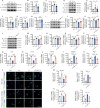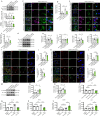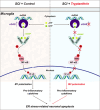Pharmacological targeting cGAS/STING/NF-κB axis by tryptanthrin induces microglia polarization toward M2 phenotype and promotes functional recovery in a mouse model of spinal cord injury
- PMID: 38993129
- PMCID: PMC11881704
- DOI: 10.4103/NRR.NRR-D-23-01256
Pharmacological targeting cGAS/STING/NF-κB axis by tryptanthrin induces microglia polarization toward M2 phenotype and promotes functional recovery in a mouse model of spinal cord injury
Abstract
JOURNAL/nrgr/04.03/01300535-202511000-00031/figure1/v/2024-12-20T164640Z/r/image-tiff The M1/M2 phenotypic shift of microglia after spinal cord injury plays an important role in the regulation of neuroinflammation during the secondary injury phase of spinal cord injury. Regulation of shifting microglia polarization from M1 (neurotoxic and proinflammatory type) to M2 (neuroprotective and anti-inflammatory type) after spinal cord injury appears to be crucial. Tryptanthrin possesses an anti-inflammatory biological function. However, its roles and the underlying molecular mechanisms in spinal cord injury remain unknown. In this study, we found that tryptanthrin inhibited microglia-derived inflammation by promoting polarization to the M2 phenotype in vitro . Tryptanthrin promoted M2 polarization through inactivating the cGAS/STING/NF-κB pathway. Additionally, we found that targeting the cGAS/STING/NF-κB pathway with tryptanthrin shifted microglia from the M1 to M2 phenotype after spinal cord injury, inhibited neuronal loss, and promoted tissue repair and functional recovery in a mouse model of spinal cord injury. Finally, using a conditional co-culture system, we found that microglia treated with tryptanthrin suppressed endoplasmic reticulum stress-related neuronal apoptosis. Taken together, these results suggest that by targeting the cGAS/STING/NF-κB axis, tryptanthrin attenuates microglia-derived neuroinflammation and promotes functional recovery after spinal cord injury through shifting microglia polarization to the M2 phenotype.
Copyright © 2025 Neural Regeneration Research.
Conflict of interest statement
Figures







Similar articles
-
PTPRO inhibition ameliorates spinal cord injury through shifting microglial M1/M2 polarization via the NF-κB/STAT6 signaling pathway.Biochim Biophys Acta Mol Basis Dis. 2024 Jun;1870(5):167141. doi: 10.1016/j.bbadis.2024.167141. Epub 2024 Mar 31. Biochim Biophys Acta Mol Basis Dis. 2024. PMID: 38565385
-
Curcumin-activated Olfactory Ensheathing Cells Improve Functional Recovery After Spinal Cord Injury by Modulating Microglia Polarization Through APOE/TREM2/NF-κB Signaling Pathway.J Neuroimmune Pharmacol. 2023 Sep;18(3):476-494. doi: 10.1007/s11481-023-10081-y. Epub 2023 Sep 2. J Neuroimmune Pharmacol. 2023. PMID: 37658943 Free PMC article.
-
RU.521 mitigates subarachnoid hemorrhage-induced brain injury via regulating microglial polarization and neuroinflammation mediated by the cGAS/STING/NF-κB pathway.Cell Commun Signal. 2023 Sep 28;21(1):264. doi: 10.1186/s12964-023-01274-2. Cell Commun Signal. 2023. PMID: 37770901 Free PMC article.
-
Research Progress on Treating Spinal Cord Injury by Modulating the Phenotype of Microglia.J Integr Neurosci. 2024 Sep 19;23(9):171. doi: 10.31083/j.jin2309171. J Integr Neurosci. 2024. PMID: 39344231 Review.
-
Spinal Cord Injury Management Based on Microglia-Targeting Therapies.J Clin Med. 2024 May 8;13(10):2773. doi: 10.3390/jcm13102773. J Clin Med. 2024. PMID: 38792314 Free PMC article. Review.
Cited by
-
Microglia overexpressing brain-derived neurotrophic factor promote vascular repair and functional recovery in mice after spinal cord injury.Neural Regen Res. 2026 Jan 1;21(1):365-376. doi: 10.4103/NRR.NRR-D-24-00381. Epub 2024 Oct 22. Neural Regen Res. 2026. PMID: 39435607 Free PMC article.
-
ELAVL1-mediated USP29 mRNA degradation activates TAK1 driving M1 microglial polarization and neural stem cell differentiation dysregulation in spinal cord injury.Cell Death Discov. 2025 Jul 9;11(1):317. doi: 10.1038/s41420-025-02604-8. Cell Death Discov. 2025. PMID: 40634288 Free PMC article.
-
Deer Antler Uridine Regulates Glycolysis in Microglia via HSP90/HIF-1α to Improve Cognitive Impairment in Alzheimer's Disease Mice.CNS Neurosci Ther. 2025 May;31(5):e70416. doi: 10.1111/cns.70416. CNS Neurosci Ther. 2025. PMID: 40365745 Free PMC article.
-
Dolutegravir Derivatives Alleviate LPS-Induced Microglial Inflammation by Suppressing STAT1/3 Nuclear Translocation.Drug Des Devel Ther. 2025 May 30;19:4567-4584. doi: 10.2147/DDDT.S520724. eCollection 2025. Drug Des Devel Ther. 2025. PMID: 40464033 Free PMC article.
-
Emerging role of microglia in the developing dopaminergic system: Perturbation by early life stress.Neural Regen Res. 2026 Jan 1;21(1):126-140. doi: 10.4103/NRR.NRR-D-24-00742. Epub 2024 Nov 13. Neural Regen Res. 2026. PMID: 39589170 Free PMC article.
References
-
- Ahuja CS, Wilson JR, Nori S, Kotter MRN, Druschel C, Curt A, Fehlings MG. Traumatic spinal cord injury. Nat Rev Dis Primers. 2017;3:17018. - PubMed
-
- Ban M, Su H, Zeng X, Chen C, Zhou S, Chen X, Nong Z. An active fraction from Spatholobus suberectus dunn inhibits the inflammatory response by regulating microglia activation, switching microglia polarization from M1 to M2 and suppressing the TLR4/MyD88/NF-κB pathway in LPS-stimulated BV2 cells. Heliyon. 2023;9:e14979. - PMC - PubMed
LinkOut - more resources
Full Text Sources
Research Materials

